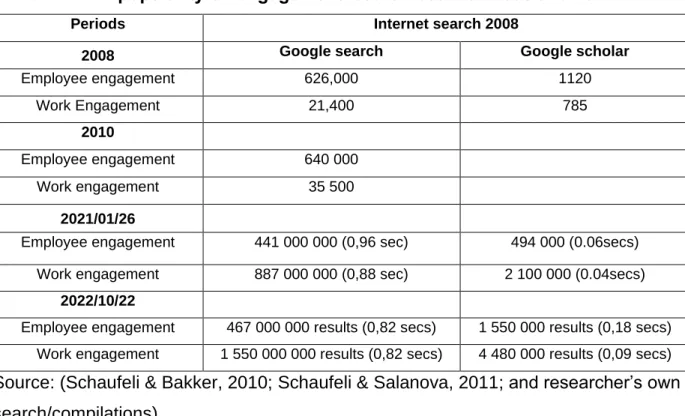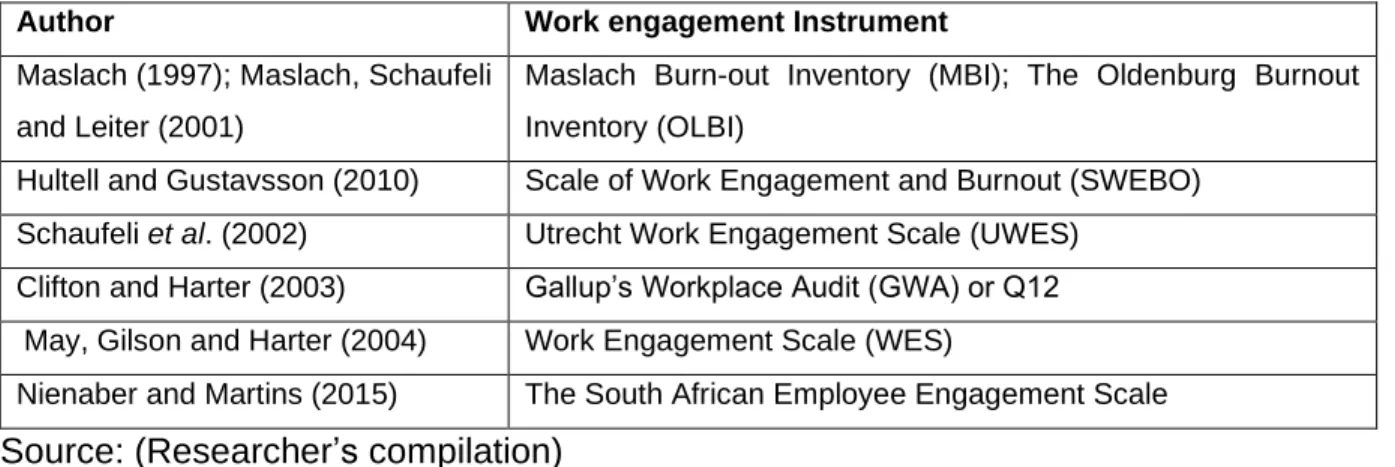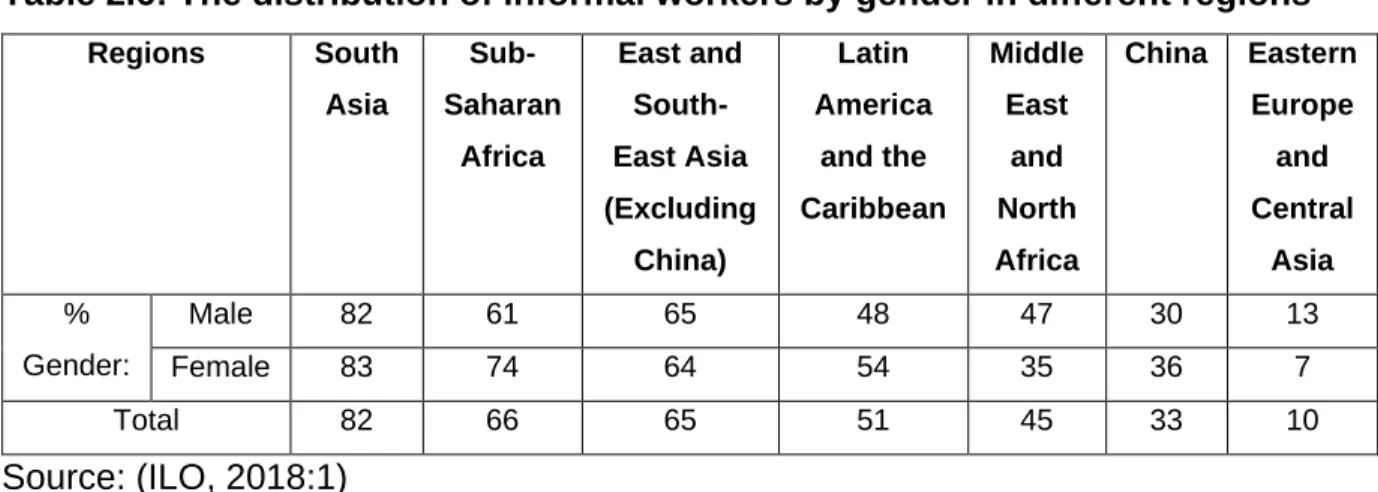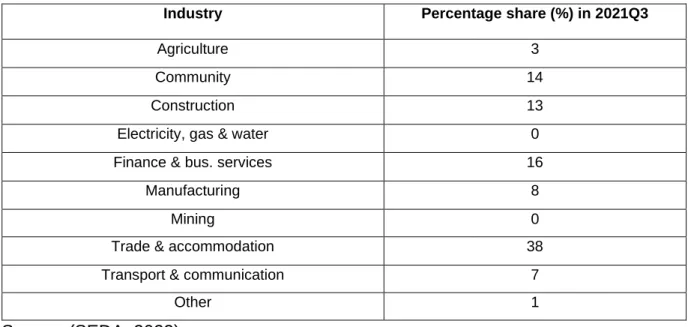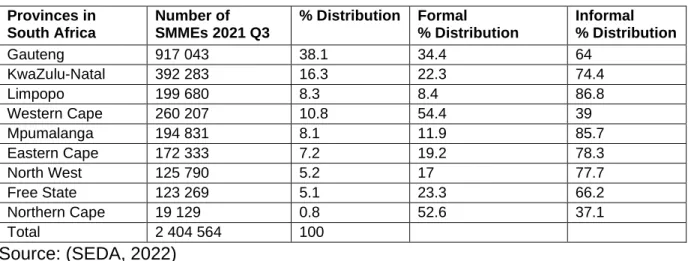Dr. Jack Chokwe, thank you for your language services earlier in the project; your work is very commendable. The study was conducted to determine the well-being at work of street traders, the most visible self-employed workers in the informal sector, by assessing their work engagement through the UWES.
INTRODUCTION
INTRODUCTION
In the present work, the focus was on the discussion of the issue of the study. In this section, the study focuses on the discussion of the data collection process.
BACKGROUND AND RATIONALE OF THE STUDY
- The importance of occupational well-being
- The importance of work engagement
- Self employment in the informal economic sector
PROBLEM STATEMENT OF THE STUDY
Second, the UWES-9 is valid for assessing the work engagement of street vendors, the most visible self-employed/own-account workers in the informal sector. In addition, the study determined the validity of the UWES in assessing the work engagement of self-employed/self-employed workers in the informal sector.
OBJECTIVES OF THE STUDY
- The primary objective of the study
- The secondary objectives of the study
Little or nothing is known about the work engagement of self-employed/own-account workers in the informal sector. Assessing the work engagement of street traders, self-employed/self-employed workers in the most visible informal sector, through the UWES-9 (one of the few reliable, valid and most widely used instruments in the assessment of work engagement ).
THE HYPOTHESES OF THE STUDY
The hypotheses of the study were formulated according to the objectives of the research. In the next part, the focus was on the discussion of the research design and the methodology of the study.
RESEARCH DESIGN AND METHODOLOGY
- Research design
- Assumption and research philosophy of the study
- Research Methodology
- Data collection instrument
- Data collection process
- Data preparation (data editing and capturing), analysis and interpretation
The focus of the current section was on the discussion of the research design for the study. The focus of this section was on the discussion of the sample size for the study.
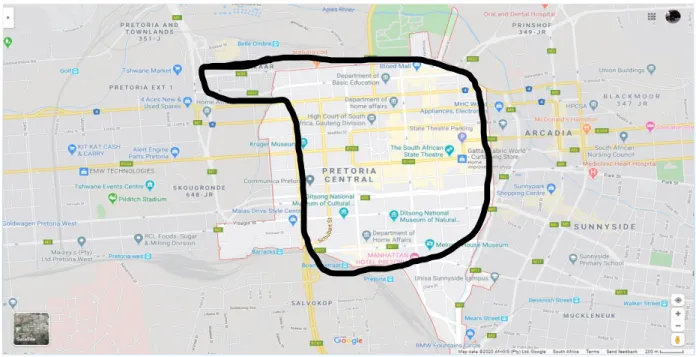
ETHICAL IMPLICATIONS OF THE STUDY
Once all comments were received and followed up and the thesis was within the acceptable index of similarity, the thesis was then submitted for examination.
SETTING OF THE STUDY
Neuman (2014) that in naturalism, the applicable principles are that the study should examine events as they unfold in natural, everyday social contexts, which will not be fabricated, invented, or researcher-created institutions. Customers could still purchase and the study would continue if and when the participant was ready to continue participating in the study.
ASSUMPTIONS, CONSTRAINTS, DELIMITATIONS, AND LIMITATIONS
Sufficient time was provided for customer interruptions so that participants/street vendors could service their customers. The reality was that street vendors are competing for customers, so if one customer comes in, the service has to be the best it can be.
CONTRIBUTION OF THE STUDY
However, most studies on work engagement have been conducted in the formal sector of the economy, with little or no attention paid to the informal sector of the economy. In addition, the contributions of the study were related and aligned with the hypothesized hypotheses, namely.
LAYOUT OF THE STUDY
It laid the foundation for the study by briefly discussing the main elements or parts of the study. Most activities related to quality assurance of the administration of the study were carried out in the chapter.
THE CHAPTER SUMMARY
The limitation section of the study provided explanations of what the study was unable to do due to factors identified in the study. The conclusion section involved an explanation of what the study has concluded, given the study's problem.
CRITICAL REVIEW OF THE LITERATURE
INTRODUCTION
THE ORIGIN OF WORK ENGAGEMENT
DEFINING WORK ENGAGEMENT
MEASUREMENT OF WORK ENGAGEMENT
SELF EMPLOYMENT IN THE INFORMAL ECONOMIC SECTOR
INFORMAL WORK, SECTOR AND ECONOMY DEFINED
SELF-EMPLOYED/OWN-ACCOUNT WORKERS (STREET TRADERS)
THE POTENTIAL OF THE INFORMAL SECTOR TO CREATE EMPLOYMENT
CHALLENGES FACING INFORMAL SECTOR (STREET TRADING)
CHAPTER SUMMARY
RESEARCH DESIGN AND METHODOLOGY
INTRODUCTION
In the previous chapter, the study focused and critically reviewed the literature on the study. The present chapter focuses on and discusses the research design and methodology of the study. To contextualize the study, the chapter begins by reviewing the research objectives and hypotheses of the study in the next section.
RESEARCH OBJECTIVES AND HYPOTHESES
To determine the factorial invariance of the UWES-9 in the assessment of street vendors' work. To assess the reliability and validity of the UWES-9 in assessing work engagement in the informal sector. The study's purpose, problem, objectives and hypotheses were outlined and used to determine which direction the study should take.
PHILOSOPHY, PARADIGM AND APPROACH TO THEORY DEVELOPMENT
- Research philosophy
- Approach to theory development
The aim and objectives of the study were achieved after solving the research problem and testing the hypotheses. It involves defining and manipulating the variables involved in the study situation (Denicolo & Becker, 2012). There are also many activities carried out in the study that outline a systematic approach to solving the identified study problem.
RESEARCH DESIGN AND METHODOLOGY
- Research design
- Research Methodology
- Sampling strategy or design
- Data Collection Process
- Data Analysis Process
In the current section, the study focuses on the discussion of the sampling strategy or design. In the current section, the focus of the study is on discussing a sample size. The focus of the current section is on the explanation of CFA in the study.

POTENTIAL SHORTCOMINGS AND SOURCES OF ERROR
The procedure was used in group analysis of variance reporting and reported in the appropriate sections of the study. In addition, to mitigate the problems associated with multicollinearity of scales, one or three factor(s) of UWES were used or calculated in the study. Most of these opportunities for error were managed in a way that maintained the objectivity of the study.
CHAPTER SUMMARY
In the present section, the focus is on the presentation of the results as analyzed. To assess the internal consistency and validity of the UWES-9 in the assessment of work engagement in the informal sector. The focus in the current section is on the explanation or discussion of the EFA processes.
PRETEST AND PILOT STUDIES (UWES-9)
INTRODUCTION
The focus of this chapter is on reporting the quality assurance report that emerged from the conduct of pre-test and pilot studies for the study entitled 'Assessing the Work Engagement of Street Traders in the City of Tshwane'. Background and rationale for pretest and pilot studies; objectives for pretest and pilot studies; how pre-test and pilot studies were conducted; results of pre-test and pilot studies; and measures taken to improve the quality of the instrument (UWES-9) and presentation of the study based on these studies were part of the report and discussion. Each of the activities described above is described in separate sections below, beginning with the background and rationale for conducting the pretest and pilot studies.
BACKGROUND AND RATIONALE FOR PRETEST AND PILOT STUDIES
However, nothing has been reported on the reliability and validity of the UWES in assessing the work engagement of street traders, the most visible self-employed/own-account worker in the informal sector. To solve the problem and achieve the purpose of the study, the study goes through various stages, including conducting pre-test and pilot studies, which are some of the basic and important phases or stages of the study, hence the focus of the study report. The rationale and purpose of conducting both the pretest and the pilot of the study are presented in the following subsections:
PRETESTING OF THE STUDY
- Procedure and reporting pretest study
Although the instrument was neither revised nor developed in the current study, the pretest was conducted. At least 10 questionnaires were administered for the pretest survey to similar participants as in the main study through personal face-to-face interviewer administered survey interviews. In the pretest survey, 10 (ten) participants were recruited to participate in the survey as already explained above.

SUMMARY OF THE PRETEST STUDY
PILOTING OF THE STUDY
- Rationale for conducting a pilot study
- Procedures and methods for data collection
- Data Analyses and reporting
Therefore, with the mean value of 0.43 in the power scale items, the internal consistency of the items is acceptable. Reliability assessment of the absorption scale was further assessed, as with the other scales. In the next section, the internal reliability assessment of the composite UWES-9 cell/instrument is presented below in Table 4.14.
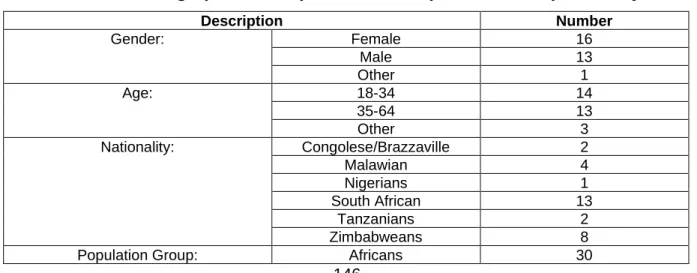
CHAPTER SUMMARY: PRETEST AND PILOT STUDIES
In the following sections, the frequencies and percentage distributions of the demographic variables are presented and discussed. To assess the factorial invariance of the UWES-9 in assessing the work of street vendors. The results of the internal consistency test of the UWES-7 show an alpha value of α.
RESULTS: PRESENTATION AND DISCUSSIONS
INTRODUCTION
Data analysis to solve the problem of the study was completed, with each section in the following section reporting on specific aspects of the data analysis activity undertaken. Therefore, the focus of the current chapter is on reporting and discussing the results of the data analyses. The conclusions report whether the study has solved the formulated problem of the study and whether the study has achieved the objectives.
DATA COLLECTION PROCESS
According to Mouton, data analysis reporting includes the discussion of the sample profile, presentation of results by means of tables or graphs, discussions of results in relation to the formulated hypotheses or themes and drawing conclusions. Some of the contributing factors were field workers' ill health, time and cost associated with data collection, which were the main contributing factors for the collection of 405, an amount short of the projected amount of completed questionnaires. Despite some of these challenges, the number of completed questionnaires was sufficient to perform the statistical analyses, meet the objectives and solve the problem of the study.
DATA CODING AND CAPTURING
When one field worker was ill, it was difficult for the other to perform work alone, and the researcher was always on standby to cover for such work. It was also difficult for the researcher to cover work done by two people. Quality assurance on the completed questionnaires was carried out at a number of stages, namely in the field, during capture and before sharing the spreadsheet computer file with the statistician for analyses.
FREQUENCY DISTRIBUTIONS
- UWES-9 Frequencies and percentage distributions
- Gender
- Age profile of the participants
- Nationality of participants
- Education status of participants
- Street traders working with or not working family members
- Employment status of participants
- Street traders belonging to other groups, e.g., stokvels
- Street traders belonging to formal groups, e.g., trade unions
In the pilot study, few participants also reported working with family member(s), whereas the majority reported not working with anyone or family member(s). In the pilot study, more street vendors reported working as street vendors influenced by agency motives with 87 percent compared to 23 percent who were influenced by structural motives. The street vendors who belong to informal groups, for example 'stokvel' or social groups, were profiled in the study as shown in Table 5.8.
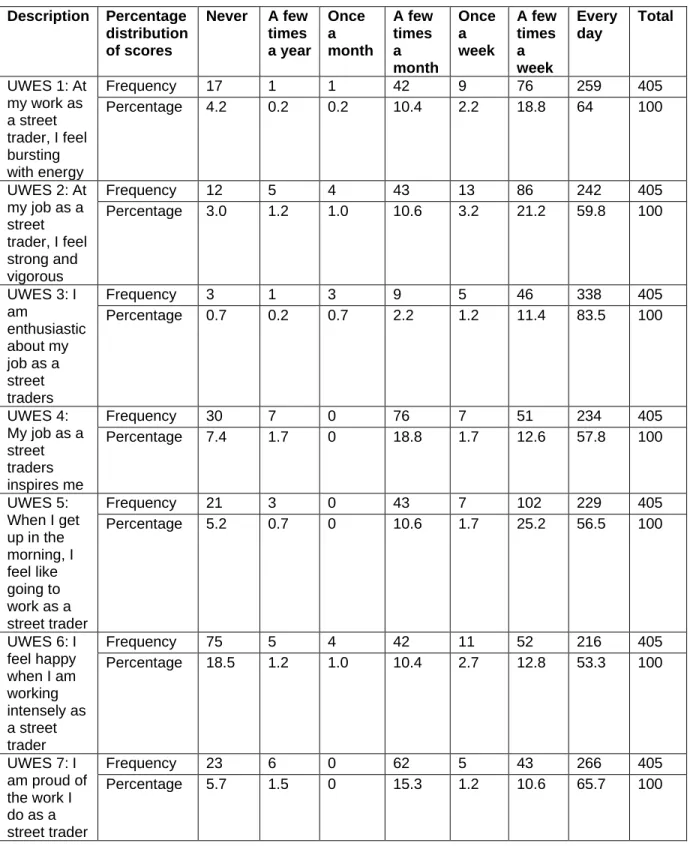
PRESENTATION OF RESULTS
- Reliability assessment of the UWES-9
- Summary of the section
Table 5.10 shows the internal consistency reliability test results, where the alpha value of the UWES-9 is α = 0.74. The mean value of the correlations between the items, as shown in Table 5.11 for the study, is X. In addition, a statistical test was performed on the summary of the items to test the reliability of the UWES-7.

FACTOR ANALYSIS
- EFA in the study
- The CFA in the study
- Summary of the section
The UWES-7 has been reported to have acceptable in-study reliability as recommended by Hair Jr et al. The null hypothesis formulated that the UWES does not have acceptable reliability for assessing the work engagement of street vendors is not supported (rejected). Despite using the UWES to assess the work engagement of street vendors, which has never been done before, EFA was not used for the current study.
GROUP ANALYSIS
- Gender and work engagement
- Age and work engagement
- Nationality and work engagement
- Education level and work engagement
- Working with or with no family member(s) and work engagement
- Informal group (stokvels) and work engagement
- Unions/associations and work engagement
- Agency and structural motives street trading and work engagement
SUMMARY
CONCLUSION AND RECOMMENDATION
INTRODUCTION
DISCUSSION, CONCLUSIONS, AND RECOMMENDATIONS
- The Reliability and vadility assessment
- Group Analysis
IMPLICATIONS OF EMPIRICAL RESULTS TO CONCEPTUAL CONCLUSSIONS
RECOMMENDATIONS FOR POLICY MARKERS
RECOMMENDATION FOR FUTURE RESEARCH
LIMITATIONS OF THE STUDY
DISCUSSION OF GAPS, ANOMALIES AND DEVIATIONS IN THE DATA
CONTRIBUTION TO KNOWLEDGE
CONCLUDING REMARKS


